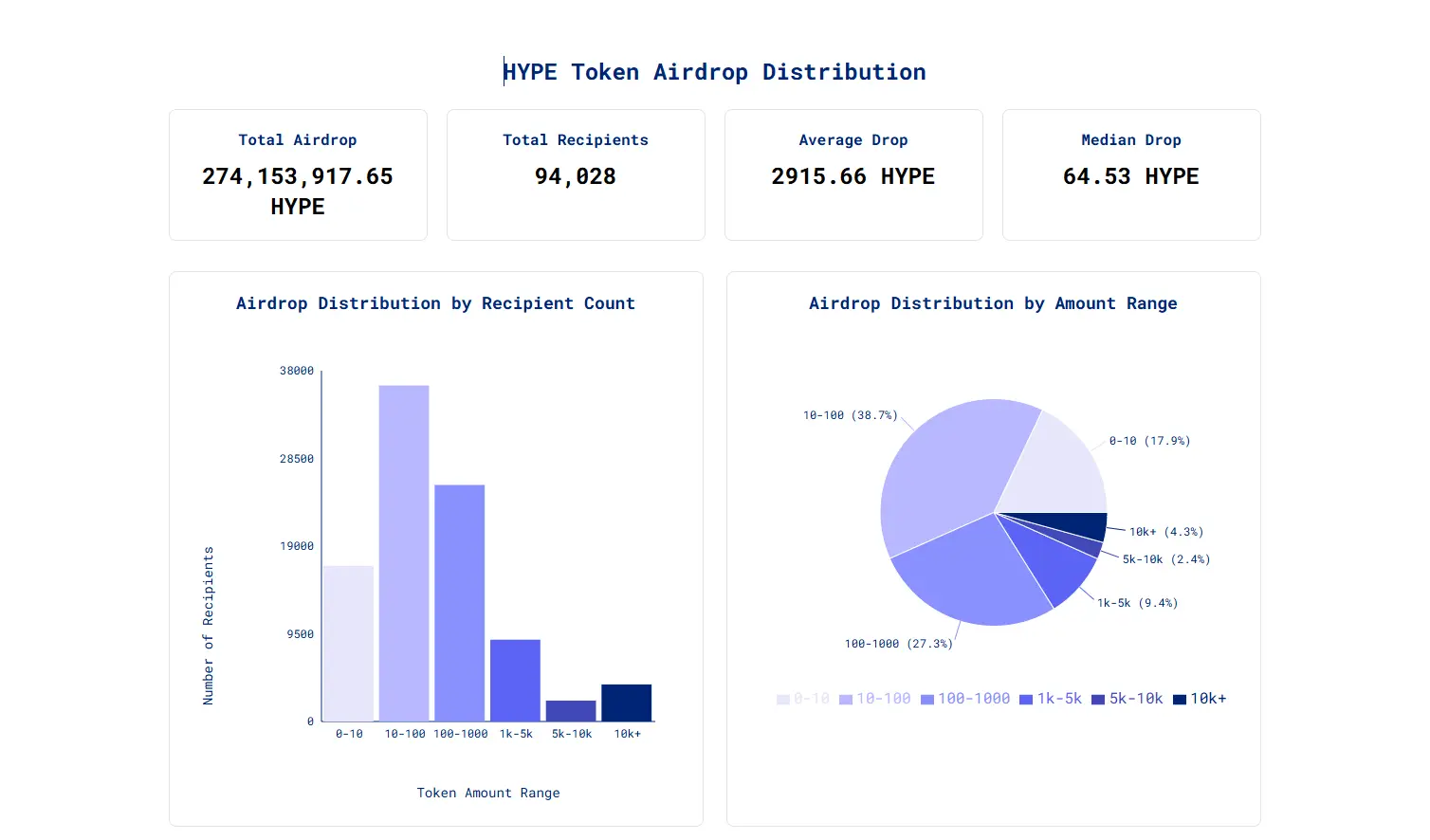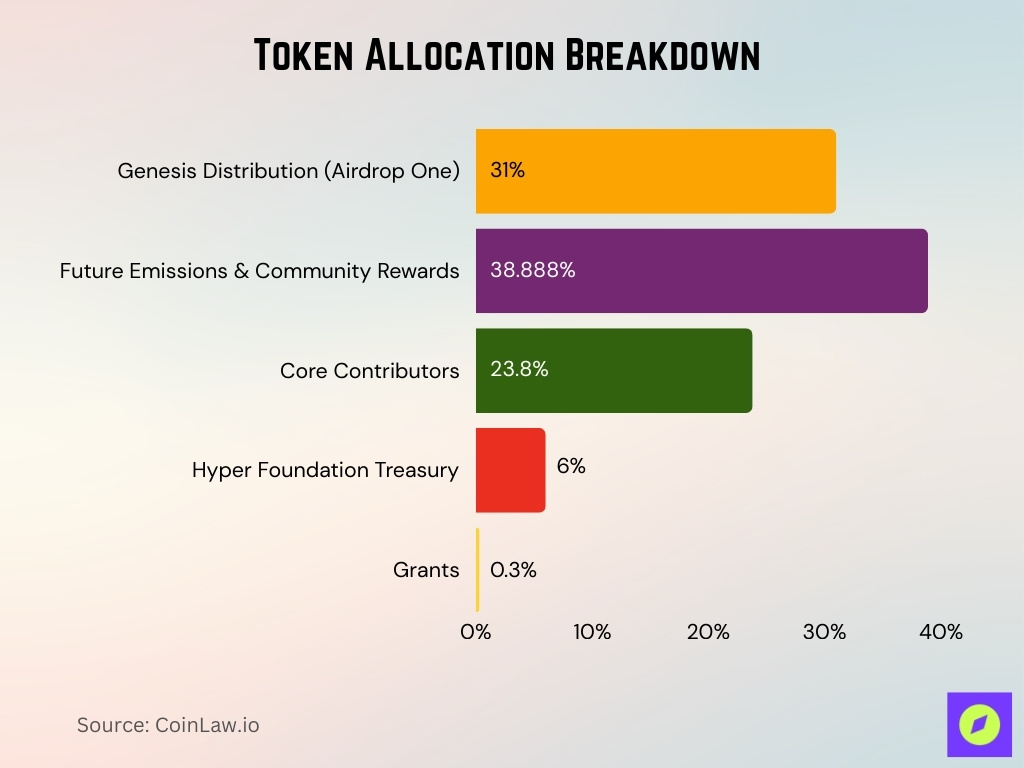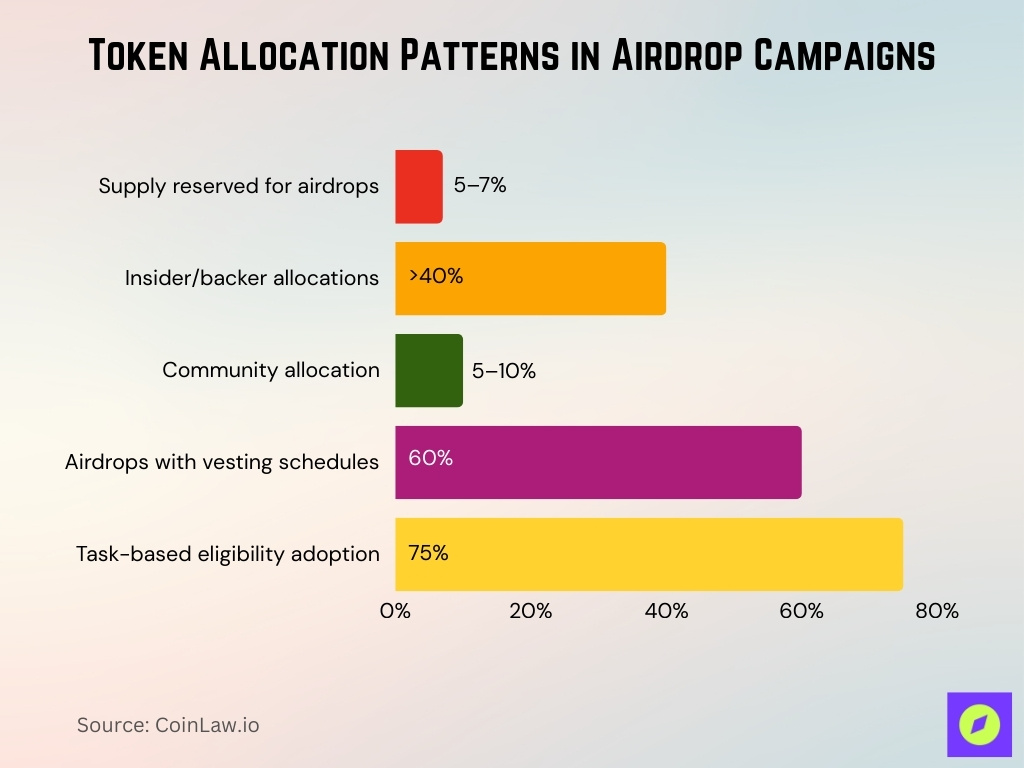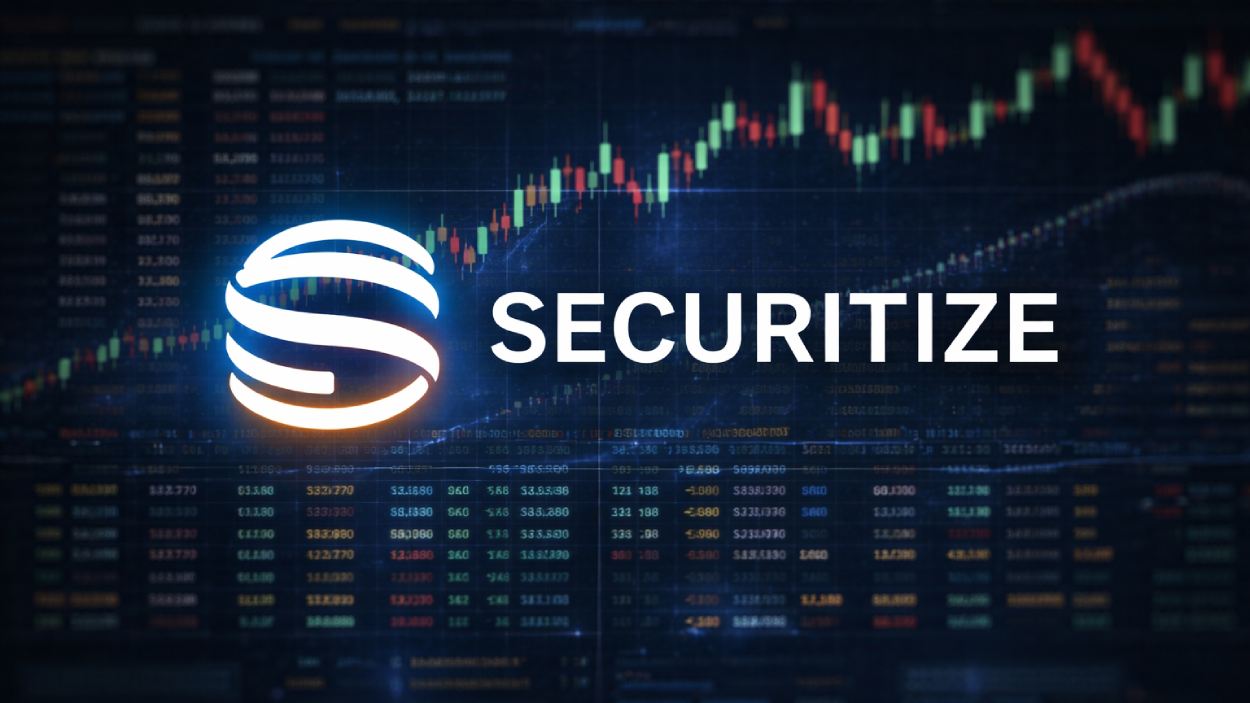Token airdrops, free distributions of cryptocurrency tokens, have become a powerful tool in the blockchain ecosystem to reward early users, kick-start networks, and engage communities. In practice, companies like Coinbase’s L2 “Base” offering early access benefits and gaming projects giving token drops to early testers show how airdrops can spur user acquisition and ecosystem activity. At the same time, DeFi protocols offering governance tokens to active users demonstrate how airdrops can drive platform loyalty and network effects. In the following sections, we’ll dive into the latest statistics to show how large this phenomenon has become and where it’s headed.
Editor’s Choice
- Total value distributed via airdrops since 2017 has exceeded $20 billion.
- In our sample of 11 airdrops, the cumulative value reached approx $7.16 billion, with about 1.9 million claimers and a median claim value of ≈ $4,600 per eligible address.
- In 2024, the share of active addresses located in the U.S. was estimated at 22‑24% of global active crypto addresses.
- By 2025, airdrop campaigns are reported to have lost some of their earlier ROI appeal; many no longer deliver the outsized returns seen previously.
- A significant concern is that many 2025 airdrops allocate a large portion of tokens to insiders, leaving smaller shares to community members.
- Roughly 88% of airdropped tokens lose value within three months of distribution.
Recent Developments
- 88% of crypto projects used airdrops in 2024, attracting 199 million participants, a 45% increase from 2022.
- In 2025, insider allocations in some airdrops reached over 40% of total tokens, raising community concerns.
- Post-airdrop, about 50% of tokens gained value while 50% lost value, with some falling by more than 50%.
- Over 64% of airdrop recipients sold their tokens immediately during the token generation event.
- U.S. users missed an estimated $1.84 billion to $2.64 billion in airdropped tokens due to geoblocking.
- 11 of 12 major airdrops implemented geoblocking, excluding U.S. users from participation.
- Sybil attacks saw fake wallets capture nearly 50% of tokens in some airdrops, harming genuine user rewards.
HYPE Token Airdrop Distribution Highlights
- 274.15 million HYPE tokens were distributed to users. This marks one of the largest airdrops in 2025 by total volume.
- 94,028 recipients participated in the airdrop event. The campaign had a wide community reach across wallet holders.
- The average drop was 2,915.66 HYPE, indicating a few large allocations. However, the median was just 64.53 HYPE, showing most users received smaller amounts.
- 38.7% of recipients got between 10–100 HYPE, the most common distribution range. This segment represented the campaign’s core user base.
- 27.3% received 100–1,000 HYPE, making it the second largest group. These users likely had mid-tier eligibility or engagement levels.
- 17.9% of wallets received just 0–10 HYPE, the smallest tier. These were likely passive or minimal-activity accounts.
- 9.4% of users were awarded 1,000–5,000 HYPE, reflecting higher engagement or contribution. This group was relatively small but notable.
- Only 2.4% received 5,000–10,000 HYPE, while just 4.3% got 10,000+ HYPE. These high-value drops likely targeted whales or core contributors.

Value and Volume of Major Token Airdrops
- The total cumulative value of airdrops (since 2017) now exceeds $20 billion.
- In 2023 alone, the value distributed via major campaigns was about $4.5 billion.
- Projections for 2025 suggest that value could be over $20 billion when including smaller, unannounced drops.
- In the 11‑project sample, the value reached about $7.16 billion across those campaigns.
- For some airdrops, the median claim value to individual participants was approximately $4,600.
- Major airdrops often target large address pools; some distribute to 100,000–1 million wallets, while “global” campaigns aim at tens of millions.
- A 2025 dashboard lists upcoming airdrops with individual reward pools of tens of millions of dollars (e.g., $25 million listed).
- Despite a large value being dropped, the effective “value capture” by participants is often reduced due to vesting, lock-ups and early sell-offs.
Number of Airdrop Participants
- In the sample of 11 airdrops, about 1.9 million addresses claimed tokens.
- Of all active crypto addresses globally, approximately 22‑24% are estimated to be from U.S. persons in 2024.
- Some campaigns list eligibility pools in the hundreds of thousands to millions of wallets.
- The shift to task‑based eligibility (testnets, bridging) means participant numbers may be lower than in earlier snapshot‑only drops.
- Geoblocking of U.S. users impacted between 920,000 and 5.2 million U.S. holders in a sample of geoblocked airdrops.
- The growth of multi‑chain and cross‑platform tasks likely increases the “qualifying pool” but also raises participation thresholds.
- Some upcoming airdrop dashboards list thousands of participants already filtered for eligibility (“+2,000” etc.).
Token Allocation Breakdown
- 38.888% of the total token supply is allocated to Future Emissions & Community Rewards. This ensures long-term ecosystem growth and user incentives.
- 31% is designated for the Genesis Distribution (Airdrop One). This represents a major upfront distribution to early users.
- 23.8% is reserved for Core Contributors. These tokens reward developers and team members driving the project forward.
- 6% is allocated to the Hyper Foundation Treasury. It will support protocol maintenance, partnerships, and operational reserves.
- 0.3% is set aside for Grants. These funds will back external builders and ecosystem innovation.

Most Profitable Token Airdrops
- A study of 30 post‑airdrop tokens found that 15 gained value and 15 lost value, with some dropping more than 50%.
- Research shows that about 64% of recipients sold their tokens immediately at the token generation event (TGE).
- Approximately 88% of airdropped tokens lose value within three months of launch.
- In one detailed sample, the average claim value per wallet was about $4,600 among roughly 1.9 million claimers.
- Of a sample of campaigns between 2019‑2023, estimated revenue lost to U.S. users (due to geoblocking) ranged from $1.84 billion to $2.64 billion.
- In 2025, high‑visibility airdrops had total rewards of up to $50,000 (for smaller tokens) in certain projects.
- Among “profitable” airdrops, many of the gains came from early birds who held rather than sold immediately, yet these remain the minority.
- A large‑scale airdrop project delivered more than $1.45 billion in distributed tokens in one campaign (MOVE token), with 98.5 % of eligible addresses receiving at least a meaningful amount.
- Despite some standout winners, many airdrops failed to deliver sustainable user engagement correlating with token value.
Geographic Distribution of Airdrop Participants
- U.S. addresses made up approximately 22‑24% of all active crypto addresses in 2024.
- Between 920,000 and 5.2 million U.S. persons were impacted by geoblocking policies across 11 analyzed airdrops (2020‑24).
- In 2024, airdrop participants globally reached ~199 million, representing a ~45% increase over ~135.8 million in 2022.
- Some airdrops explicitly excluded U.S. users, which led to significant participation being shifted to non‑U.S. jurisdictions.
- Multi‑chain drops (e.g., Ethereum + Solana) have grown in 2025, reaching wider global participation beyond traditional hubs in North America and Europe.
- Emerging markets (e.g., Southeast Asia, Africa) are increasingly targeted due to lower claim costs and high mobile/crypto adoption, though exact percentages remain less publicly detailed.
- Referral and point-system-based eligibility (i.e., tasks) in 2025 allow broader global participation, reducing single‑country dominance.
Token Allocation Strategies
- Industry guidelines suggest reserving 5-7% of total token supply for airdrops, often in 3-5 phases.
- Some projects allocate over 40% of tokens to insiders/backers, with community allocations as low as 5-10%.
- 75% of recent airdrops used task-based eligibility, such as testnet participation or social media tasks.
- 60% of projects implement vesting schedules to reduce immediate sell-off after airdrop release.

- Around 50% of airdrops combine token distribution with governance rights for recipients.
- Multi-chain allocation across Ethereum, Solana, and Layer 2s increased by 30% in 2025.
- Anti-Sybil mechanisms are included in 85% of new token allocation designs to prevent fraud.
- Despite more projects doing airdrops, the average airdrop value per project dropped by 20% in 2025.
- Vesting schedules typically have a cliff period of 12 months followed by a gradual release over 3-4 years.
Percentage of Tokens Sold Post‑Airdrop
- 64% of airdrop recipients sold their tokens immediately at TGE.
- More than 66% of projects saw price drops after distribution.
- 88% of tokens had lost value within three months.
- Some projects saw token accumulation by top wallets. In the MOVE airdrop, 1.14% of addresses received more than 10,000 tokens.
- The immediate sell‑off behaviour often correlates with a lack of vesting or utility for the token beyond claim‑and‑dump.
- Campaigns with longer lock‑ups and utility built in saw comparatively lower sell rates.
- Projects with allocations >10% of supply to airdrops reportedly perform better in terms of stability than those with <5%.
Unclaimed Token Airdrop Statistics
- An estimated $45 billion worth of tokens remained unclaimed across multiple campaigns.
- In the MOVE campaign, about 580 million out of ~1 billion tokens (~58%) were unclaimed.
- Approximately 20% of eligible recipients did not claim their tokens due to a lack of awareness or effort.
- Projects using airdrop dashboards and alerts reduced unclaim rates by 30-40%.
- Smaller-value airdrops tend to have higher unclaim rates, sometimes exceeding 50%.
- The cost of funds locked in unclaimed tokens represents missed growth opportunities for protocols.
- Regulatory losses include an estimated $418 million in U.S. federal tax revenue from unclaimed airdrops between 2020-2024.
- U.S. users missed over $1.8 billion in airdropped tokens due to regulatory restrictions and geoblocking.
Airdrop Impact on Platform Activity (TVL, Transactions)
- Airdrops trigger spikes up to 2.5 million daily transactions at launch.
- Activity typically drops to 20-40% above baseline in weeks after.
- TVL linked to liquidity airdrops often rises 50%+ but may decline thereafter.
- Only about 30-40% of claimers convert to core users.
- Cross-chain transactions increase by 10-30% after airdrops.
- Withdrawals post-claim phase reduce retained TVL by up to 40%.
- Gaming/social dApp airdrops can increase user counts by over 70% but lower value per user by 20-30%.

Airdrop ROI (Return on Investment) Statistics
- 88% of tokens distributed via airdrops lose value within the first three months.
- Of 30 major airdrops from 2024, 15 posted gains while 15 suffered losses, some declining by more than 50%.
- A campaign distributing > 10% of its total token supply via airdrop showed better price stability than those distributing < 5%.
- Projects with a high fully diluted valuation (FDV) at the time of airdrop were more likely to see negative ROI.
- Early claimers who held tokens for longer periods had markedly higher ROI than those who sold immediately.
- In 2025, the projected total value of airdrops remains high (over $20 billion), yet ROI expectations are being revised downward.
Community Retention Rates
- The OP airdrop (“Airdrop 5”) increased 30‑day retention by 4.2 percentage points and 60‑day retention by 2.8 points.
- User activity reverts to only 20–40% above pre‑airdrop levels within weeks.
- Airdrop campaigns in 2024 reported very limited long‑term retention.
- Task‑based eligibility led to slightly higher retention.
- Share of recipients still active after three months is often under 30%.
- Retention is higher when recipients receive governance rights or ongoing utility.
- Eligibility based on frequency of transactions may attract short-term speculators.
- Farming and Sybil-type participation are linked to lower retention.
- Retention often determines whether an airdrop yields meaningful community building or just a short‑lived bump.
Exchange Distribution and Selloff Patterns
- Over 60% of an airdrop was claimed by a single entity using 14,000 wallets.
- Many recipients sell immediately at token generation, causing quick price pressure.
- High token concentration in large wallets leads to accelerated selloffs.
- Tokens without vesting schedules see earlier and higher sell-off volumes by up to 70%.
- Listing tokens too early often triggers sharp price drops, sometimes exceeding 50%.
- Multi-chain airdrops display fragmented selloff patterns across networks.
- Anti-Sybil systems are implemented by more than 85% of projects in 2025.
Risks and Challenges in Token Airdrop Campaigns
- Over 65% of DeFi protocols faced challenges like wash trading and low engagement in 2024.
- Sybil farming remains a major threat, with bots and fake wallets skewing distributions in 85% of campaigns.
- Tokens with high fully diluted valuations (FDV) at launch are up to 70% more likely to crash post-airdrop.
- Low liquidity causes price volatility, with some tokens dropping 15-50% due to liquidity traps.
- Regulatory scrutiny has increased by 30% in 2025, impacting airdrop legality and execution.
- Claiming costs sometimes exceed token value, with gas fees 2-5x higher than average airdrop rewards.
- Poor communication lowers engagement rates by 40%, reducing campaign effectiveness.
- Reward fatigue causes participation drop-offs of 25-35% in ongoing airdrop campaigns.
- Airdrops alone fail to drive retention without aligned incentives, as 60% of recipients become inactive.
Frequently Asked Questions (FAQs)
88% of airdropped tokens lose value within three months.
One campaign reported an 81% rate of eligible recipients.
Up to 30% of recipients in major drops were Sybil wallets.
Approximately 1.2 million new active wallets were onboarded in 60 days.
Conclusion
The landscape of token airdrops is evolving. While airdrops remain a useful tool for onboarding users and distributing tokens, the statistical landscape shows major caveats: the vast majority of tokens lose value quickly, retention of users is often low, and without proper design, the impact on protocol activity can be fleeting. Projects that tie airdrops to utility, enforce vesting, fight Sybil attacks and align incentives show significantly better outcomes. For participants, success increasingly comes from holding, engagement and selecting projects with strong fundamentals, not simply chasing free tokens. As the next wave of airdrops unfolds, both issuers and claimants would benefit from data‑driven strategies rather than hype‑driven tactics.
Hover or focus to see the definition of the term.


























































